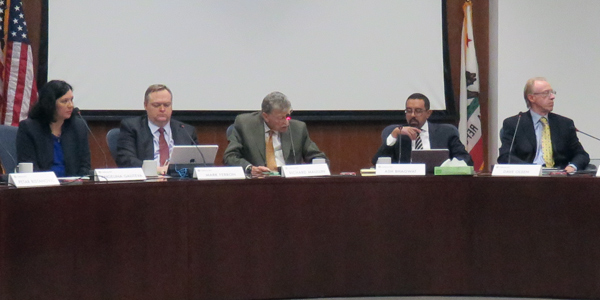By Jason Fordney
FOLSOM, Calif. — CAISO’s Board of Governors on Thursday approved new generator contingency modeling, rules extending time for generator interconnections and enhancements to the Western Energy Imbalance Market (EIM).
The board made several unanimous votes and also approved CAISO’s 2018 budget of $197.2 million, which funds ISO operations and salaries based on fees collected from system users. The budget grew by 1% from last year. (See CAISO Seeks Bump in Spending, Revenue Requirement.)
CME Initiative Approved
The board approved a new tool that will allow dispatch of generation to return energy flows to normal levels within a required time frame following the loss of major infrastructure. The contingency modeling enhancements (CME) proposal took years to develop, said Keith Casey, CAISO vice president of infrastructure and market development.
“This was some four years in the making to bring this to you today,” Casey told the board, which unanimously approved the measure with little discussion.
CAISO developed the CME initiative to address a Western Electricity Coordinating Council reliability provision requiring grid operators to return a critical transmission path to its system operating limit within 30 minutes of a destabilizing event, such as the loss of a generator or transmission line.
The ISO currently dispatches generation to ensure that output does not exceed system limits, but its market model does not consider how to dispatch in a way that returns a line to normal operating limits within the required time. CAISO has been relying on “minimum online commitment constraints” that dispatch generation to meet constraint requirements, but generators are not compensated for the capacity made available to meet contingencies, and exceptional — or out-of-market — dispatch is used to return the transmission system to normal.
The new modeling creates “corrective capacity” in the day-ahead and real-time markets, and resources would be paid for the locational corrective capacity they provide.
Southern California Edison and the Six Cities group of Southern California municipal utilities opposed the change, saying it has limited benefit. SCE said the measure also introduces complexity and makes market prices less transparent. Powerex supported the changes but said it should not be implemented until CAISO overhauls its congestion revenue rights policy. (See CAISO Finalizes Constraint Tool Proposal.)
During the stakeholder process, CAISO removed a provision that would have applied the methodology to lines not subject to the 30-minute restoration time frame, saying it would develop an additional policy in that regard if needed. The ISO also declined a stakeholder suggestion to allow bidding for “corrective capacity” intended to reduce flows across a line within 30 minutes of a contingency, saying the measure would be complex and difficult to mitigate for market power.
New Interconnection Rules
The board also approved a change to CAISO’s generator interconnection policies that will extend the time projects can remain in the queue. The revision is designed to help renewable projects stay financially viable as utility-scale procurement of renewables declines.
“This change will provide additional time to validate and correct interconnection request submittals, which should further streamline the efficiency of the overall interconnection study process,” Casey said in a memo to the board. The change requires approval by FERC.
Many load-serving entities require that generators complete the second phase of the ISO’s interconnection process to qualify for procurement. There is typically about a four-month window between Phase II reports and a transmission deliverability allocation. While projects can currently sit in the queue for a year, there has been a sharp increase in the number of projects unable to secure power purchase agreements before being dropped from the queue.
The new rules extend by a year the “parking” period in the queue, and the ISO also intends to examine its transmission planning deliverability qualification criteria in 2018. (See CAISO Launches Generator Interconnection Effort.)
Governor David Olsen said the proposal is “a good faith effort by the ISO to accommodate the slowdown of project development, especially renewable resources, that we are facing.” But he added “we are under no illusions that taking this step is going to do anything effectively to address the underlying problems behind the effective suspension of procurement.”
That issue, according to Olsen, is rooted in the development of distributed resources and the loss of utility load, “which could very materially affect the ability to develop [utility-scale] renewable resources in the near future. Those are issues that are going to have to be addressed by others.” Olsen said that all parties involved in California policies should ensure that clean energy development can proceed.
The board also approved a set of EIM enhancements that represent a pared-down version of a package proposed earlier this year. The EIM Governing Body in late November approved the package, which automates some manual processes, facilitates bilateral settlements and improves the market’s modeling accuracy. (See EIM Governing Body Approves ‘Consolidated’ Initiatives.)
In executive session, the board also promoted Jodi Ziemathis, the ISO’s executive director of human resources, to vice president of human resources. Chief Financial Officer and Treasurer Ryan Seghesio was also named vice president, while retaining his current titles.







